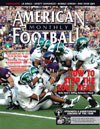AMERICAN FOOTBALL MONTHLY THE #1 RESOURCE FOR FOOTBALL COACHES
Article CategoriesAFM Magazine
|
The Speed Report: The Essence of High School Combines and Your Playersby: Dale BaskettFootball Speed Specialist © More from this issue High school combines nationally have mushroomed over the last five years. Is it a fad or is it here to stay? Personally, I think it will stay for a while. Some years ago I was living in Seattle and for a point in time was the speed coach for the Seattle Seahawks. I was obviously aware of the NFL combines that were conducted at that level. In those days the statistics recorded by the organizations were strictly confidential; they were not public knowledge. Today, the combines are live on television. However, the statistics are still highly regarded information for qualifying selective choices. The NFL combines afford an overview of how the athletes perform in the flesh. Film study obviously doesn’t tell you everything. Coaches get to see how the athletes compete against other peers as they try to gain favor. The NFL....The full article can only be seen by subscribers. Subscribe today!
|
|
|||||||
| HOME |
MAGAZINE |
SUBSCRIBE | ONLINE COLUMNISTS | COACHING VIDEOS |
Copyright 2025, AmericanFootballMonthly.com
All Rights Reserved





